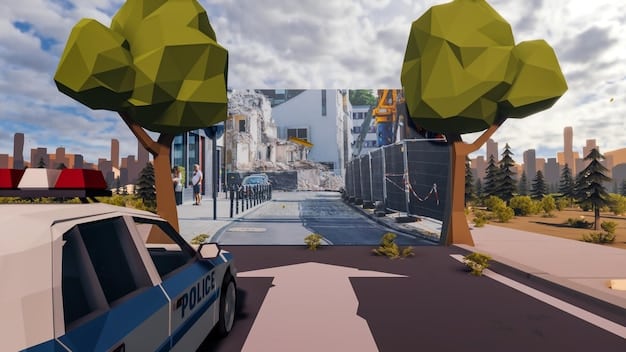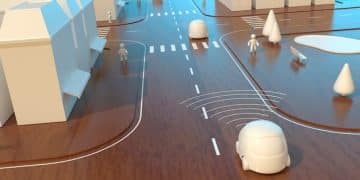LiDAR vs. Radar: Which Sensor Tech Will Lead Self-Driving Cars by 2026?
Radar and LiDAR are key sensor technologies for self-driving cars, but while radar excels in varied weather conditions, LiDAR provides high-resolution 3D mapping; by 2026, the dominant technology will likely depend on cost reduction, performance improvements and the specific requirements of autonomous driving systems.
The race to perfect self-driving cars is heating up, and two sensor technologies are at the forefront: LiDAR and radar. The question is, in the landscape of autonomous vehicles, LiDAR vs. Radar: Which Sensor Technology Will Dominate Self-Driving Cars by 2026?
Understanding LiDAR Technology
LiDAR, which stands for Light Detection and Ranging, is a remote sensing technology that utilizes laser light to create a high-resolution 3D map of the surrounding environment. It plays a critical role in enabling self-driving cars to perceive and navigate the world around them.
By emitting rapid pulses of laser light and measuring the time it takes for the light to return after reflecting off objects, LiDAR systems can accurately determine the distance, shape, and size of those objects.
How LiDAR Works in Autonomous Vehicles
LiDAR sensors in autonomous vehicles work by continuously scanning the environment with laser beams. These beams bounce off objects, and the sensor measures the round-trip time. This data is then used to create a detailed 3D point cloud, which the car’s software interprets to understand the surroundings.
Key Advantages of LiDAR
- High-resolution 3D mapping of the environment
- Accurate object detection and distance measurement
- Detection of small obstacles and fine details
LiDAR’s ability to create detailed 3D maps makes it invaluable for self-driving cars, allowing them to make informed decisions. However, it’s essential to consider LiDAR’s limitations and how they compare to alternative technologies.
Exploring Radar Technology
Radar, or Radio Detection and Ranging, is another crucial sensor technology used in self-driving cars. Unlike LiDAR, which relies on light, radar uses radio waves to detect objects and measure their distance and speed.
Radar technology has been around for decades and is well-established in automotive safety systems, such as adaptive cruise control and blind-spot monitoring.
How Radar Functions in Autonomous Vehicles
Radar sensors emit radio waves that bounce off objects, and the sensor measures the time it takes for the waves to return. This provides information about the object’s distance, speed, and direction. Radar can penetrate various weather conditions, making it reliable in rain, fog, and snow.
Key Advantages of Radar
- Reliable performance in adverse weather conditions
- Long-range detection capabilities
- Accurate measurement of object speed
Radar’s ability to function in various weather conditions makes it an essential component of self-driving car sensor suites. However, it has limitations in terms of resolution compared to LiDAR.
LiDAR vs. Radar: Key Differences
When comparing LiDAR and radar, several key differences emerge that impact their performance and suitability for self-driving applications. Understanding these differences is crucial for predicting which technology will dominate by 2026.
The primary differences lie in the type of waves they use, their resolution, and their performance in different weather conditions.
Resolution and Accuracy
LiDAR systems generally offer higher resolution and accuracy compared to radar. LiDAR can detect smaller objects and finer details, providing a more detailed representation of the environment. Radar, while less precise, can still provide valuable information about object distance and speed.
Performance in Different Weather Conditions
One of the most significant differences between LiDAR and radar is their performance in adverse weather conditions. Radar excels in rain, fog, and snow, while LiDAR’s performance can be significantly degraded in these conditions. Heavy rain or fog can scatter the laser light used by LiDAR, reducing its range and accuracy.
Cost Considerations
Cost is another critical factor in the LiDAR vs. radar debate. LiDAR systems have historically been more expensive than radar systems, although prices have been decreasing in recent years. The higher cost of LiDAR can be a barrier to widespread adoption, especially in lower-priced vehicles.

While LiDAR offers superior resolution and accuracy, radar’s reliability in various weather conditions and lower cost make it a strong contender in the self-driving car sensor market.
The Role of Sensor Fusion
Sensor fusion is the process of combining data from multiple sensors to create a more comprehensive and accurate perception of the environment. In self-driving cars, sensor fusion typically involves integrating data from LiDAR, radar, cameras, and other sensors.
By combining the strengths of different sensors, sensor fusion can overcome the limitations of individual sensors and improve the overall reliability and safety of autonomous driving systems.
Benefits of Sensor Fusion
- Increased accuracy and reliability
- Redundancy in case of sensor failure
- Improved perception in challenging conditions
Challenges of Sensor Fusion
Despite its benefits, sensor fusion also presents challenges. One of the main challenges is dealing with the different data formats and characteristics of various sensors. Integrating data from LiDAR, radar, and cameras requires sophisticated algorithms and processing power.
Another challenge is managing the computational load. Processing data from multiple sensors in real-time can be resource-intensive, requiring powerful onboard computers.
Sensor fusion is a crucial aspect of self-driving technology, allowing cars to “see” the world in a more complete and reliable way. However, its successful implementation requires overcoming significant technical challenges.
Future Trends and Predictions
Looking ahead to 2026, several trends and predictions can help shed light on which sensor technology will dominate the self-driving car market. These include advancements in sensor technology, cost reductions, and regulatory developments.
Technological innovation and market forces will play a significant role in shaping the future of LiDAR and radar in autonomous vehicles.
Advancements in LiDAR Technology
LiDAR technology is rapidly evolving, with new solid-state LiDAR systems emerging that are smaller, more robust, and less expensive than traditional mechanical LiDAR systems. Solid-state LiDAR uses electronic beam steering instead of mechanical rotation, making it more durable and reliable.
Cost Reductions
The cost of LiDAR sensors has been a major barrier to widespread adoption, but prices are expected to continue to decrease as production volumes increase and new manufacturing techniques are developed. Lower-cost LiDAR systems will make self-driving technology more accessible to a wider range of vehicles.
Regulatory Developments
Regulatory developments and safety standards will also influence the adoption of LiDAR and radar in self-driving cars. Governments and industry organizations are working to establish clear guidelines for autonomous vehicle testing and deployment. These guidelines are likely to address sensor requirements and performance standards.
The interplay of technological advancements, cost reductions, and regulatory developments will determine the future landscape of sensor technology in self-driving cars.
Expert Opinions and Industry Insights
To gain further insights into the LiDAR vs. radar debate, it’s valuable to consider the opinions of experts and industry leaders. Many experts believe that a combination of both technologies will be necessary for achieving full autonomy.
Leading automotive manufacturers and technology companies are investing heavily in both LiDAR and radar, recognizing the unique strengths of each technology.
Statements from Industry Leaders
- “LiDAR provides the high-resolution data needed for precise object detection, while radar offers reliability in adverse weather conditions.” – CEO of a leading autonomous vehicle company
- “Sensor fusion, combining LiDAR, radar, and cameras, is the key to achieving robust and safe autonomous driving.” – CTO of a major automotive supplier
Expert Analysis
Experts agree that no single sensor technology can provide a complete solution for self-driving cars. LiDAR and radar, combined with cameras and other sensors, create a robust and redundant sensing system. This redundancy ensures that the vehicle can still operate safely even if one or more sensors fail or are impaired.
While LiDAR offers unparalleled resolution and accuracy, radar’s ability to function in all weather conditions makes it an indispensable component of autonomous driving systems. The future likely involves a balanced approach, leveraging the strengths of both technologies.
| Key Point | Brief Description |
|---|---|
| 💡 LiDAR Technology | Uses laser light for high-resolution 3D mapping, crucial for object detection. |
| 📡 Radar Technology | Employs radio waves to detect objects, reliable in diverse weather conditions. |
| 🌧️ Weather Performance | Radar excels in rain and fog, while LiDAR’s performance can degrade. |
| 🤝 Sensor Fusion | Combining data from LiDAR, radar, and cameras enhances accuracy and safety. |
Frequently Asked Questions
▼
LiDAR’s primary advantage is its ability to create high-resolution 3D maps of the environment. This allows for more precise object detection and distance measurement compared to radar.
▼
Radar performs better than LiDAR in adverse weather conditions such as rain, fog, and snow. Radio waves used by radar can penetrate these conditions more effectively than the laser light used by LiDAR.
▼
Sensor fusion is the process of combining data from multiple sensors, such as LiDAR, radar, and cameras, to create a more comprehensive and accurate perception of the environment. It increases safety and reliability.
▼
Yes, LiDAR systems are becoming more affordable due to advancements in technology and increased production volumes. This trend is making LiDAR more accessible for a wider range of vehicles.
▼
It is unlikely that one sensor technology will completely dominate. The most likely scenario is a combination of LiDAR, radar, and cameras working together through sensor fusion to provide safe autonomous driving.
Conclusion
In the ongoing LiDAR vs. radar debate, it’s clear that both technologies offer unique advantages for self-driving cars. While LiDAR excels in providing high-resolution 3D mapping, radar offers reliability in adverse weather conditions. As we move closer to 2026, the most likely scenario is a continued integration of both LiDAR and radar, along with cameras and other sensors, to create robust and safe autonomous driving systems, with the specific dominance dependent on cost, performance improvements, and regulatory standards.





